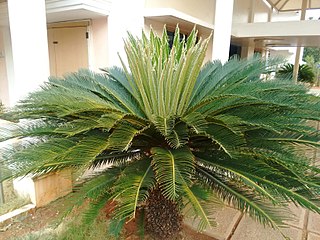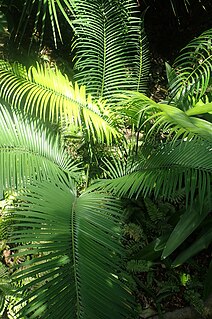
Cycas is a genus of plants belonging to a very ancient lineage, the Cycadophyta, which are not closely related to palms, ferns, trees or any other modern group of plants. They are evergreen perennials which achieved their maximum diversity in the Jurassic and Cretaceous periods, when they were distributed almost worldwide. At the end of the Cretaceous, when the non-avian dinosaurs became extinct, so did most of the cycas in the Northern Hemisphere.

Cycas balansae is a species of cycad in the genus Cycas, native to southwestern China and adjacent northern Vietnam, where it occurs in dense mountain rainforests.

Cycas beddomei is a species of cycad in the genus Cycas, native to India, where it is confined to a small area of Andhra Pradesh state in the Tirumala Hills in scrubland and brush covered hills.

Cycas micronesica is a type of cycad found in the island of Yap in Micronesia, the Marianas islands of Guam and Rota, and The Republic of Palau. It is commonly known as Federico nut or Fadang in Chamorro. The species, previously lumped with Cycas rumphii or Cycas circinalis, was described in 1994 by Ken Hill. Paleoecological studies have determined that C. micronesica has been present on the island of Guam for about 9,000 years. It is linked with the human degenerative disease Lytico-Bodig disease, which is similar to amyotrophic lateral sclerosis (ALS) through a neurotoxin (BMAA) in the seeds, which were a traditional food source on Guam until the 1960s.

Cycas taitungensis is a species of genus Cycas endemic to Taitung County, south-eastern Taiwan. C. taitungensis, an evergreen tree, can grow up to about 5 m (16 ft) tall. The species was not described until 1994, but its specimen was once applied as the type of species Cycas taiwaniana, which is not really distributed in Taiwan according to the further research.

Cycas rumphii, commonly known as queen sago or the queen sago palm, is a dioecious gymnosperm, a species of cycad in the genus Cycas native to Indonesia, New Guinea and Christmas Island. Although palm-like in appearance, it is not a palm.

Cycas thouarsii, the Madagascar cycad, is an evergreen arborescent cycad in the genus Cycas. It is named after a French botanist Louis-Marie Aubert du Petit-Thouars (1758—1831).
Cycas ferruginea is a plant species native to Vietnam and to the Guangxi region of China. It grows on rocky crevices in forested areas at elevations of 200–500 m. It is known from a belt of limestone bluffs in Lang Son Province and Thai Nguyen Province in Vietnam, and in western Guangxi Province, China. It is also cultivated at the Guilin Botanical Garden, Guangxi.

Cycas annaikalensis is a Critically Endangered species of cycad in the genus Cycas, native to the state of Kerala in India, where it is endemic to the Annaikal Hills near Palakkad. It was discovered in 2006. There are less than 100 individuals remaining.

Cycas multipinnata is a species of cycad in southwestern China and northern Vietnam.
Cycas clivicola is a species of cycad in Thailand, Cambodia, Vietnam, and Malaysia. It is found on limestone outcrops, as well as on offshore islands.
Cycas dolichophylla is a species of cycad in northern Vietnam and southern China.
Cycas falcata is a little-known species of cycad endemic to Indonesia. It is found in Southeast Sulawesi and Kabaena Island.
Cycas fairylakea is a species of cycad endemic to China. There are only two subpopulations left in eastern Guangdong province, China.

Cycas riuminiana, commonly known as the Arayat pitogo or simply pitogo, is a species of cycad endemic to Luzon, Philippines. It is also locally known as bayit in Tagalog and sawang in Ilocano, among other names.

Cycas zambalensis is a species of cycad endemic to Luzon, Philippines.

Cycas wadei is a species of cycad endemic to Culion island, Philippines. There is only one subpopulation of about 5,000 mature individuals, located in a small area to the east of Halsey Harbor.
Cycas tropophylla, the Ha Long cycad, is a species of cycad endemic to Vietnam.
Cycas saxatilis is a species of cycad found only on Saint Paul's Mountain, Palawan, Philippines.
Cycas shanyaensis is a species of cycad endemic to Hainan, China.











